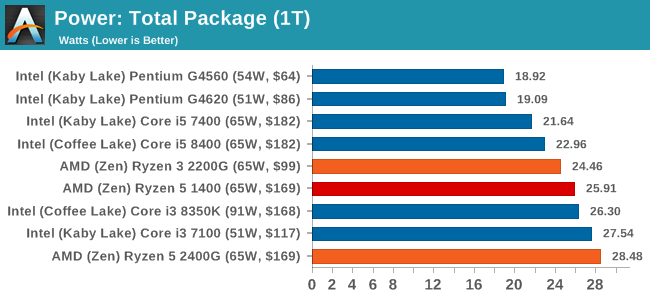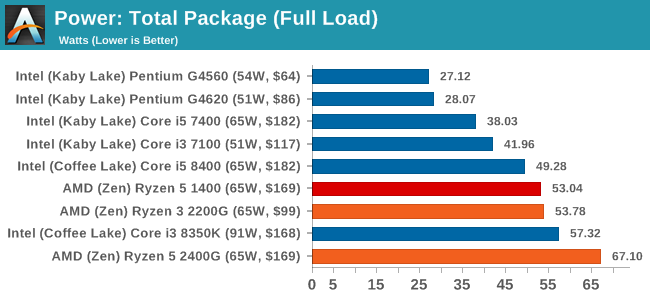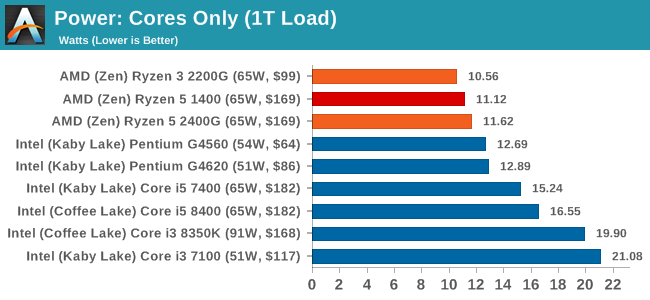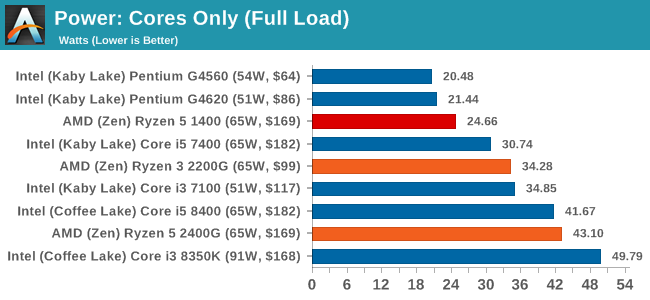Marrying Vega and Zen: The AMD Ryzen 5 2400G Review
by Ian Cutress on February 12, 2018 9:00 AM ESTPower Consumption
For our power consumption metrics, we use a Prime 95 blend on fixed threads to generate a strong load, and then poll the internal power registers that determine power state calculations to get the power consumption. Each processor is different in how it reports its power, which depends on the level of control the processor has: some of the more advanced CPUs, such as Ryzen, will provide per-core power numbers, while the latest Intel CPUs only give a figure for the CPUs as a whole but also include DRAM controller and uncore power consumption.
An interesting element to the power consumption on the Ryzen APUs, due to the unified power delivery subsystem in play feeding the CPU and the integrated graphics, is that the power registers only report half the power consumption when probed (e.g. when 14W, shows 7W). As of yet, we are unsure if this has a knock-on effect on how the processor adjusts its turbo modes in response to power consumption. Nonetheless, a simple scaling factor gives the following results.
Total Package: The Whole Processor
For this data, we take the values of the processor as a whole, which includes all the interconnect, memory controllers, PCIe root complexes, etc. The system is still only loading the CPU cores with minimal effect on the rest of the system, however depending on how the power is managed, some of the sub-systems still remain enabled.


At full load, the difference between the Ryzen 5 and the other Ryzen CPUs shows that the 2400G is using more of its upper margin, compared to the 1400 which is rated at the same power (note TDP is only determined at the base frequency), but the extra frequency of the 2400G means that there is extra power draw overall. Part of this is due to the Infinity Fabric, which we will see below. But what these tests also underline is that in a quad-core configuration, the Intel CPUs are still very power efficient.
Cores Only: Pure Work
For the processors that split out the data, we can look at the power consumption of the cores on their own, without any of the sub-systems, like uncore, mesh, or infinity fabric. This usually paints a different picture to the package power.


For the core only power, the Ryzen 5 2400G uses less power than the Core i3-8350K, despite the situation being reversed when considering the whole package. This means that Infinity Fabric takes a lot of power here, and the ring bus solution that Intel uses benefits from being simpler, and Intel can push more power to its individual cores.










177 Comments
View All Comments
HStewart - Monday, February 12, 2018 - link
I don't get the idea of desktops except if you want ultimate gaming PC - go with High End CPU a long with High End GPU. Otherwise go mobile. You can pretty much go that route unless you desired extreme top end performanceIf you primary into game get a Xbox One X or S and HDTV are cheap or PS 4,
But lower end desktop PC - I see no need them for now. Times have changed
Lolimaster - Monday, February 12, 2018 - link
If you wanna upgrade a laptop, be prepared for a bunch of cabling.Have 3-4 drives on mobile?
Dedicated capture/sound card?
Keep your thermals in check?
Upgrade your cpu/apu whenever you like?
mikato - Saturday, February 17, 2018 - link
To me laptops are annoying, and only convenient for basic tasks with their mobility. Otherwise they are slow, have a small screen, often don’t a have mouse, and no number pad on keyboard. As a result, typing is slower, pointing is slower, app speed is slower, and gaming performance is worse. With the smaller screen, juggling things, dragging files, etc is more difficult. I just can’t get stuff done as well on a laptop as a desktop.oldschool_75 - Monday, February 12, 2018 - link
Why do the Intel systems have 32 gigs of ram while the AMD systems only have 16?Also bulldozer was not 2 cores 4 threads, it was two modules with two cores sharing the modules so 4 cores.
Lolimaster - Monday, February 12, 2018 - link
Why use 2933 memory?As far as i know AMD send 3200 CL14 Flare X to pretty much everyone for the sake of testing the gpu at 3200 CL14 !!!!
jjj - Monday, February 12, 2018 - link
They use the frequencies officially supported , anything above that is OC and would fall into the OC section. It's debatable how right or wrong that is but that's what AT does.Lolimaster - Monday, February 12, 2018 - link
Guru3d got the reviewer's kit with 3200 cl14 flare-x as 100% of the techtoubers too.ScottSoapbox - Monday, February 12, 2018 - link
The number of typos in the first two sentences was enough for me to stop reading.Lolimaster - Monday, February 12, 2018 - link
The avrg l3 latency for non-APU multiple CCX Ryzen's was around 11-12ns, on the single CCX APU is aroun 9.5ns.Memory latency Ryzen
91ns DDR4 2400
77ns DDR4 3200
2400G
66ns DDR4 3200
Macpoedel - Monday, February 12, 2018 - link
Good to see you started testing CPU's with maximum supported RAM speed instead of JEDEC frequency. These APU's would have really suffered if tested with 2133MHz DDR4 RAM.